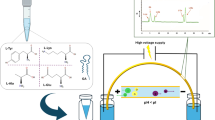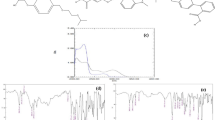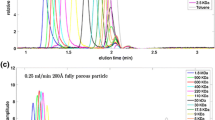Abstract
Several chiral reagents including cyclodextrins (CDs) and derivatives, crown ethers, proteins, chiral surfactants, and polymers have been involved in dual-selector systems for enantioseparation of a series of compounds by capillary electrophoresis (CE). In this paper, chondroitin sulfate D-based dual-selector system (CSD/CM-β-CD) was firstly established and investigated for the enantioseparation of six basic racemic drugs in capillary electrophoresis. Compared to the single-selector systems, synergistic effect and significantly improved separations for all tested analytes were observed in CSD/CM-β-CD system. The effect of several parameters, such as buffer pH, chiral selector concentration, and applied voltage, was systematically optimized. Meanwhile, to investigate the possible chiral recognition mechanisms in CSD/CM-β-CD synergistic system, we tried to apply the molecular docking method to simulate the host-guest binding procedures of the polysaccharide-based dual system for the first time. The difference in binding free energy was found to correspond to the chiral selectivity factor. The existence of CSD-CM-β-CD complex may give rise to a higher discriminatory ability against the enantiomers, indicating the synergistic effect in CSD/CM-β-CD system.

ᅟ




Similar content being viewed by others
References
Horvâth C, Nikelly JG. Capillary electrophoresis and chromatography[J]. Anal Chem. 1990;62(20).
Wang Z, Ouyang J, Baeyens WRG. Recent developments of enantioseparation techniques for adrenergic drugs using liquid chromatography and capillary electrophoresis: a review [J]. J Chromatogr B Anal Technol Biomed Life Sci. 2008;862(1):1–14.
Du YX, Honda S, Taga A, et al. A novel polybrene/chondroitin sulfate C double coated capillary and its application in capillary electrophoresis [J]. Chin J Chem. 2002;20(12):1557–65.
Chen B, Du Y. Evaluation of the enantioseparation capability of the novel chiral selector clindamycin phosphate towards basic drugs by micellar electrokinetic chromatography [J]. J Chromatogr A. 2010;1217(11):1806–12.
Cucinotta V, Contino A, Giuffrida A, et al. Application of charged single isomer derivatives of cyclodextrins in capillary electrophoresis for chiral analysis [J]. J Chromatogr A. 2010;1217(7):953–67.
Escuder-Gilabert L, Martín-Biosca Y, Medina-Hernández MJ, et al. Cyclodextrins in capillary electrophoresis: recent developments and new trends [J]. J Chromatogr A. 2014;1357:2–23.
Saz JM, Marina ML. Recent advances on the use of cyclodextrins in the chiral analysis of drugs by capillary electrophoresis [J]. J Chromatogr A. 2016;1467:79–94.
Zhu F, Du Y, Chen J, et al. Enantioselective separation of basic drugs by CE with polygalacturonic acid as a novel chiral selector [J]. Chromatographia. 2009;69(11–12):1315–20.
Yang F, Du Y, Chen B, et al. Enantiomeric separation of nefopam hydrochloride by affinity electrokinetic chromatography using chondroitin sulfate A as chiral selector and its chiral recognition mechanism [J]. Chromatographia. 2010;72(5–6):489–93.
Tabani H, Fakhari AR, Nojavan S. Maltodextrins as chiral selectors in CE: molecular structure effect of basic chiral compounds on the enantioseparation [J]. Chirality. 2014;26(10):620–8.
Jang J, Cho SI, Chung DS. Comparative studies of various run buffers for chiral capillary electrophoresis using chiral crown ether as a chiral selector [J]. Electrophoresis. 2001;22(20):4362–7.
Kakhki RM, Assadi H. Capillary electrophoresis analysis based on crown ethers [J]. J Incl Phenom Macrocycl Chem. 2015;81(1–2):1–12.
Yu T, Du Y, Chen B. Evaluation of clarithromycin lactobionate as a novel chiral selector for enantiomeric separation of basic drugs in capillary electrophoresis [J]. Electrophoresis. 2011;32(14):1898–905.
Greño M, Castro-Puyana M, Ángeles García M, et al. Analysis of antibiotics by CE and CEC and their use as chiral selectors: an update [J]. Electrophoresis. 2017.
Chen J, Du Y, Zhu F, et al. Evaluation of the enantioselectivity of glycogen-based dual chiral selector systems towards basic drugs in capillary electrophoresis [J]. J Chromatogr A. 2010;1217(45):7158–63.
Müllerová L, Dubský P, Gaš B. Twenty years of development of dual and multi-selector models in capillary electrophoresis: a review [J]. Electrophoresis. 2014;35(19):2688–700.
Chen J, Du Y, Zhu F, et al. Study of the enantioseparation capability of chiral dual system based on chondroitin sulfate C in CE [J]. Electrophoresis. 2015;36(4):607–14.
Su Y, Mu X, Qi L. Development of a capillary electrophoresis system with Mn (II) complexes and β-cyclodextrin as the dual chiral selectors for enantioseparation of dansyl amino acids and its application in screening enzyme inhibitors [J]. RSC Adv. 2015;5(36):28762–8.
Zhang Y, Du S, Feng Z, et al. Evaluation of synergistic enantioseparation systems with chiral spirocyclic ionic liquids as additives by capillary electrophoresis [J]. Anal Bioanal Chem. 2016;408(10):2543–55.
Zhang Q, Du Y, Chen J, et al. Investigation of chondroitin sulfate D and chondroitin sulfate E as novel chiral selectors in capillary electrophoresis [J]. Anal Bioanal Chem. 2014;406(5):1557–66.
Park KL, Kim KH, Jung SH, et al. Enantioselective stabilization of inclusion complexes of metoprolol in carboxymethylated β-cyclodextrin [J]. J Pharm Biomed Anal. 2002;27(3):569–76.
Faucci MT, Melani F, Mura P. Computer-aided molecular modeling techniques for predicting the stability of drug–cyclodextrin inclusion complexes in aqueous solutions [J]. Chem Phys Lett. 2002;358(5):383–90.
Bikádi Z, Fodor G, Hazai I, et al. Molecular modeling of enantioseparation of phenylazetidin derivatives by cyclodextrins [J]. Chromatographia. 2010;71(1):21–8.
Shi J, Ding Z, Hu Y. Theoretical study on chiral recognition mechanism of methyl mandelate enantiomers on permethylated β-cyclodextrin [J]. J Mol Model. 2012;18(2):803–13.
Lavecchia A, Cosconati S, Novellino E, et al. Exploring the molecular basis of the enantioselective binding of penicillin G acylase towards a series of 2-aryloxyalkanoic acids: a docking and molecular dynamics study [J]. J Mol Graph Model. 2007;25(6):773–83.
Bednarek E, Bocian W, Michalska K. NMR and molecular modeling study, as complementary techniques to capillary electrophoresis method to elucidate the separation mechanism of linezolid enantiomers [J]. J Chromatogr A. 2008;1193(1):164–71.
Elbashir AA, Suliman FEO. Computational modeling of capillary electrophoretic behavior of primary amines using dual system of 18-crown-6 and β-cyclodextrin [J]. J Chromatogr A. 2011;1218(31):5344–51.
Suliman FEO, Elbashir AA. Enantiodifferentiation of chiral baclofen by β-cyclodextrin using capillary electrophoresis: a molecular modeling approach [J]. J Mol Struct. 2012;1019:43–9.
Li W, Liu C, Tan G, et al. Molecular modeling study of chiral separation and recognition mechanism of β-adrenergic antagonists by capillary electrophoresis [J]. Int J Mol Sci. 2012;13(1):710–25.
Issaraseriruk N, Shitangkoon A, Aree T. Molecular docking study for the prediction of enantiodifferentiation of chiral styrene oxides by octakis (2, 3-di-O-acetyl-6-O-tert-butyldimethylsilyl)-γ-cyclodextrin [J]. J Mol Graph Model. 2010;28(6):506–12.
Melani F, Pasquini B, Caprini C, et al. Combination of capillary electrophoresis, molecular modeling and NMR to study the enantioselective complexation of sulpiride with double cyclodextrin systems [J]. J Pharm Biomed Anal. 2015;114:265–71.
Armstrong DW. Separation of enantiomers by capillary electrophoresis using pentosan polysulfate [J]. Electrophoresis. 1999;20:162–70.
Feng L, Fawaz R, Hovde S, et al. Crystal structures of Escherichia coli branching enzyme in complex with cyclodextrins [J]. Acta Crystallogr D. 2016;72(5):641–7.
Morris GM, Huey R, Lindstrom W, et al. AutoDock4 and AutoDockTools4: automated docking with selective receptor flexibility [J]. J Comput Chem. 2009;30(16):2785–91.
M.F. Sanner, R. Huey, S. Dallakyan, S. Karnati, W. Lindstrom, G.M. Morris, B. Norledge, A. Omelchenko, D. Stoffler, G. Vareille. AutoDockTools, Version 1.4.5, The Scripps Research Institute, La Jolla, CA, USA, 2007.
Ravichandran S, Collins JR, Singh N, et al. A molecular model of the enantioselective liquid chromatographic separation of (R, S)-ifosfamide and its N-dechloroethylated metabolites on a teicoplanin aglycon chiral stationary phase [J]. J Chromatogr A. 2012;1269:218–25.
Zhang X, Wang J, Hong C, et al. Design, synthesis and evaluation of genistein-polyamine conjugates as multi-functional anti-Alzheimer agents [J]. Acta Pharmacol Sin. 2015;5(1):67–73.
Németh K, Tárkányi G, Varga E, et al. Enantiomeric separation of antimalarial drugs by capillary electrophoresis using neutral and negatively charged cyclodextrins [J]. J Pharm Biomed Anal. 2011;54(3):475–81.
Fang L, Du Y, Hu X, et al. Carboxymethyl β-cyclodextrin as chiral selector in capillary electrophoresis: enantioseparation of 16 basic chiral drugs and its chiral recognition mechanism associated with drugs' structural features [J]. Biomed Chromatogr. 2017;31
Funding
This work was supported by the Project of National Natural Science Foundation of China (No.: 81072610), the Natural Science Foundation of Jiangsu Province (Program No.: BK20150697), and the Project of the Priority Academic Program Development of Jiangsu Higher Education Institutions (PAPD).
Author information
Authors and Affiliations
Corresponding author
Ethics declarations
Conflict of interest
The authors declare that they have no conflict of interest.
Rights and permissions
About this article
Cite this article
Yang, X., Yan, Z., Yu, T. et al. Study of the enantioselectivity and recognition mechanism of chiral dual system based on chondroitin sulfate D in capillary electrophoresis. Anal Bioanal Chem 410, 5889–5898 (2018). https://doi.org/10.1007/s00216-018-1208-2
Received:
Revised:
Accepted:
Published:
Issue Date:
DOI: https://doi.org/10.1007/s00216-018-1208-2




